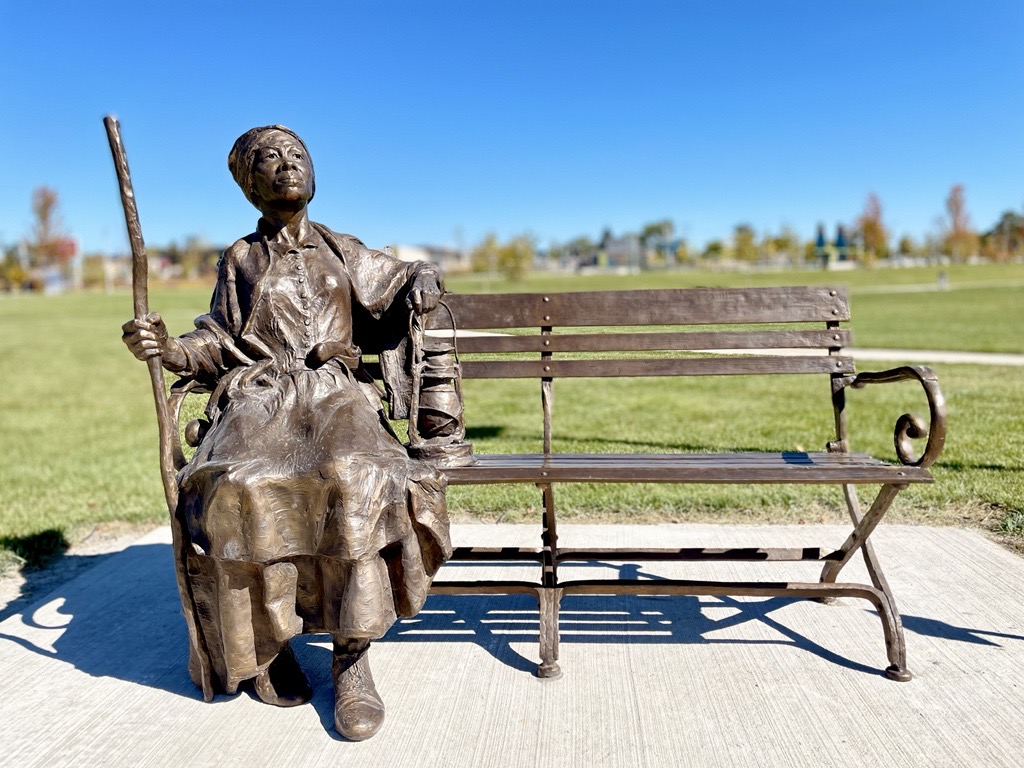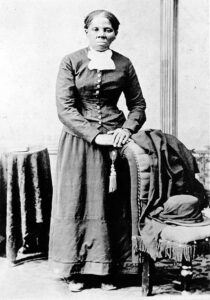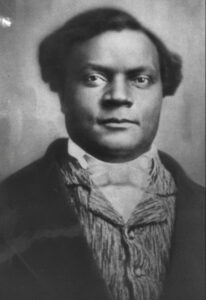
Artist: Gary Lee Price
The project to bring Harriet Tubman to South Bend began in the summer of 2021 during a conversation among two couples. One of the couples had recently returned from St. George, UT where they had seen and admired a life-sized statue of Harriet Tubman in an annual exhibition of sculptors from across the country. So impressed were they with the sculpture, they purchased a maquette. As we talked about Harriet Tubman’s extraordinary American story of courage and resilience, we quickly determined that the Tubman sculpture belonged in South Bend. We imagined scores of children and families, students and teachers, sitting on the bench conversing with Harriet and being inspired by this brave African American woman who believed in freedom and dignity for all.
We wish to thank all those who contributed in small and large measure. In the spirit of Harriet Tubman, each gift is cherished. A special thanks to Gladys W. Muhammad whose indomitable fortitude and community leadership mirror Harriet Tubman’s.
Alfred J. Guillaume, Jr.
 Harriet Tubman (1820-1913) was born in slavery in Maryland and given the name Araminta Ross. She suffered brutal treatment when she was taken from her family and “hired out” to care for a White family’s baby, when she herself was only five years old. When she was a teenager, an overseer hit her in the head with a heavy weight when she was trying to protect another enslaved person, causing headaches and narcoleptic episodes for the rest of her life. She married a free Black man named John Tubman in 1844 and escaped from slavery in 1849 with two of her brothers. It was at this time that she re-named herself Harriet Tubman.
Harriet Tubman (1820-1913) was born in slavery in Maryland and given the name Araminta Ross. She suffered brutal treatment when she was taken from her family and “hired out” to care for a White family’s baby, when she herself was only five years old. When she was a teenager, an overseer hit her in the head with a heavy weight when she was trying to protect another enslaved person, causing headaches and narcoleptic episodes for the rest of her life. She married a free Black man named John Tubman in 1844 and escaped from slavery in 1849 with two of her brothers. It was at this time that she re-named herself Harriet Tubman.
Though she was relatively safe in Philadelphia, Pennsylvania, but she felt a spiritual calling to help others escape. Risking her life, she returned to the South (mainly Maryland and Virginia) about 13 times to rescue others out of slavery. Working with abolitionists in Delaware, she traveled on the ground, on rivers, on trains and on the ocean, helping at least 70 enslaved African Americans to reach freedom in the North. She was a “conductor” on the “Underground Railroad,” leading daring missions during the fall and winter when the nights were long and she and groups of fugitives from slavery could travel undercover. Tubman collected donations for these rescues, but she also earned money doing domestic work and selling pies, saving for her winter missions. John Tubman refused to leave Maryland, but, starting in 1851, many of her sisters, extended family, and finally her mother and father, joined her in her new winter home in St. Catharine’s, Canada. In the summers, Tubman would do domestic labor in resorts like Cape May, New Jersey, saving money for her annual fall expeditions to rescue the enslaved. Around 1858, she bought a home in Auburn, New York, from Senator William Seward, an abolitionist and later, U.S. Secretary of State.
Harriet Tubman said “slavery is war,” and she carried a gun on her dangerous rescue missions into the South and back. Bounty hunters and slave owners had the law on their side, but she had her friends and her faith in God. In the North in 1860, she helped lead a rescue of Charles Nalle, a freedom seeker who had escaped from Virginia, but was captured by a slave catcher in Troy, New York and sentenced in court to be returned to slavery. Tubman disguised herself as an old woman selling food and grabbed Nalle, dragging him down the stairs of the courthouse while guards beat her and Nalle with their clubs. In the waiting crowd, her accomplices pulled her and Nalle away to safety and took them across the river, where, unfortunately, Nalle was captured again. Tubman did not give up and led a mob of abolitionists to storm the courthouse yet again and she and other Black women pulled Nalle out and into a wagon heading west. It is no wonder that John Brown, who also declared war on slavery, called her “General Tubman.”
During the Civil War (1861-1865), Harriet Tubman served as a spy and a scout in the Sea Islands of South Carolina. Tubman worked tirelessly as a nurse for Black troops, but she was also given a pass as a soldier and led raids on Confederate plantations. In this way, she freed over 700 men, women, and children, who escaped to Union lines. After the war, Harriet Tubman married a Union soldier, Nelson Davis, adopted a daughter, and supported the campaign for women to get the right to vote. In 1896, in Auburn, New York, Tubman bought a larger home and afarmstead to shelter orphaned Black children and elderly African Americans, who were not welcome at white-run institutions. To help herself and the many people she cared for, Harriet Tubman sought a soldier’s pension for her time in the Union army. In 1899, when she was about 79 years old, Congress finally passed a bill allowing her to receive it. In 1913, she died and was buried with military honors at Auburn Cemetery.
Harriet Tubman never came to South Bend, but there were members of the Underground Railroad in Indiana and Michigan. James Washington, an African American barber, helped freedom seekers out of his barbershop, housed above J.G. Bartlett & Sons, bakery and grocery store, located at 117 W. Washington St. Solomon Palmer was a white abolitionist, who lived in Union Township in the area that is currently east of Potato Creek State Park. Black farmers were part of that area, which was named Huggart Settlement for the first Black family who moved there. Fugitives from slavery sometimes hid in Palmer’s mill, while on their journey. They had to move on to Michigan, because Indiana was not safe for fugitives from slavery.
 In 1847, bounty hunters went into Cass County, Michigan, and kidnapped Lucy Powell and her children, who had all escaped from slavery in Kentucky. A group of African Americans and European American abolitionists came after the bounty hunters and demanded Mrs. Powell and the children’s release. A judge in the St. Joseph County courthouse in downtown South Bend eventually let the family go free. African Americans from Michigan and Indiana rejoiced as they accompanied their friends back to Michigan. Black and white Vandalia and Cassopolis, Michigan residents continued to support the Underground Railroad, which reached through Fountain City in southeastern Indiana, where European American Quakers Levi and Catharine Coffin made their home into an active depot.
In 1847, bounty hunters went into Cass County, Michigan, and kidnapped Lucy Powell and her children, who had all escaped from slavery in Kentucky. A group of African Americans and European American abolitionists came after the bounty hunters and demanded Mrs. Powell and the children’s release. A judge in the St. Joseph County courthouse in downtown South Bend eventually let the family go free. African Americans from Michigan and Indiana rejoiced as they accompanied their friends back to Michigan. Black and white Vandalia and Cassopolis, Michigan residents continued to support the Underground Railroad, which reached through Fountain City in southeastern Indiana, where European American Quakers Levi and Catharine Coffin made their home into an active depot.
Harriett Tubman may not have been here, but the hundreds of Michiana residents who contributed to this sculpture by artist Gary Lee Price wanted to honor her bravery and the spirit of helping other freedom seekers. That spirit also was also present among a brave few in Michiana in the 1800s. Tubman not only risked her life, but devoted the rest of her life to helping other African Americans when slavery was defeated. What would you risk your life for? How might we today repair the harm that centuries of slavery caused? You can reflect on these questions and others as you sit next to this sculpture of Harriet Tubman.
Monica Maria Tetzlaff, Ph.D.
Department of History
Indiana University South Bend
References
Clinton, Catherine. Harriet Tubman: The Road to Freedom. New York: Little, Brown, and Company, 2004.
Coffin, Levi. Reminiscences of Levi Coffin. Cincinnati : Western Tract Society, 1879.
Furlong, Patrick J. “The South Bend Fugitive Slave Case” in Patrick J. Furlong, et al, We the people : Indiana and the United States Constitution : Lectures in Observance of the Bicentennial of the Constitution. Indianapolis: Indiana Historical Society, 1987.
Lemmons, Kasi, director. Harriet. Film. Universal Pictures Home Entertainment, 2019.
“Harriett Ross Tubman.” The Black Past. https://www.blackpast.org/african-american-history/tubman-harriet-ross-c-1821-1913/
“Harriet Tubman: A Legacy of Resistance.” Meridians , Vol. 12, No. 2, (2014).
The entire issue is devoted to articles on Harriet Tubman.
“Local African American History,” The History Museum https://www.historymuseumsb.org/local-african-american-history/
“A Look Back: Blacks Shape South Bend,” South Bend Tribune, February 9, 2015.
Lowry, Beverly. Harriet Tubman: Imagining A Life. Anchor, 2008.
Lowry, a novelist, includes imagined scenes, as well as historically researched information.
Michals, Debra. “Harriet Tubman.” National Women’s History Museum. https://www.womenshistory.org/education-resources/biographies/harriet-tubman
Singer, Alan. “We May Never Know the Real Harriet Tubman.” Afro-Americans in New York Life and History. Vol. 36, No. 1 (2012), 64-85.
The South Bend Fugitive Slave Case : Involving The Right to a Writ of Habeas Corpus. New York: Anti-Slavery Society, 1851.
Contributors
- African American Community Fund
- Akens, Margaret
- Andrews, Dea
- Barker, Sy & Cheryl
- Bell, Tammy
- Bersheit, John
- Blake-Smith, Dorine
- Blake, Bemis & Family
- Blake, David & Ruth
- Blake, Delonda
- Blake, Hardie & Perl
- Blake, Robert
- Blake, Walter
- Blunk, Henry & Mabel
- Boetsma, Mark & Tammy
- Boggs, Wilbur
- Bonner, Thomas & Judith
- Broden, John & Jo
- Brooks, Patricia
- Brookshire, Linda
- Burish, Thomas & Pamela
- Butkovitch, John & Mary Ann
- Calvin, Richmond & Virginia
- Carson, Cleo
- Claeys, Pamela
- Clark, Anthony & Darlette
- Clark, Forrest
- Coleman, Lynn & Myrtle
- Community Foundation of St. Joseph County
- Culbertson, Hal & Rhonda
- Curlee, James A.
- Cushing, Nimbilasha
- Dahlstron, Kendall & Nancy
- Davis, Ray
- Derose, Aladean
- Dickson, Bessie
- Divine, Paul & Ann
- Doering, Elizabeth
- Everett, Ed & Rose, Kitty
- First Unitarian Church
- Fischbach, Thomas & Susan
- Fletcher, Alison
- Ford, Susan & Scott
- Fowler, Kareemah
- Freeman, Bernice Baul
- Friedland, Michael
- Gaasch, James & Pendleton, Dorothy
- Gabrielle Robinson & Mike Keen
- Garett, Taylor
- Gibney, Maggie & McClain, Jacob
- Goodwin, Dean & Sherri
- Guillaume, Alfred J., Jr. & Smith-Guillaume, Melanie
- Hackett, Patricia and Rita E. Koehler
- Hamilton, Beatrice
- Hardin, Danya
- Harris, Dina & Murray, Bil
- Harris, Rose
- Hayes Family Foundation
- Henderson, Vincent & Angela
- Herman, Margie
- Hollingsworth, Josh
- Hoover, Bonita
- Hughes, Rolanda
- Hunt, Isaac & Yolanda
- Jackson, Forestine & AD
- Judd Leighton Foundation
- Kane, Daniel & Kara
- Karakatsanis, Neovi & Swarts, Jonathan
- Kill, Bob & Pat
- Kill, Robert C. & Courtney R.
- Kitchen, Jessica
- Klein, Paul & Mary Ellen
- Kleindist, Jennifer
- Laney, Linda
- Latourette, Bonnie
- Leininger, Nels & English, Gail
- Leonardo, Margaret
- Lewis, Jay & Gretta Roemer
- Links of South Bend
- Logan, Oliver & Marlene
- Lottie, Cornelius
- Macon, Calvin & Sharon
- Marnocha, Thomas & Laura
- McAfee, Mary
- McBride, Sharon
- McClein, Jacob & Gibney, Maggie
- McGraw, Ann
- McGreevy, John and Jean McManus
- McNally, Tamara
- MLK Celebration Committee
- Morgenau, Caz
- Mroczek, Denuise & John
- Muhammad, Crescent
- Muhammad, Gladys
- Murphy, Chris & Carmi
- Mustillo Family Fund
- Nashel, Jonathan & Brickenham, Rebecca
- Neal, Mark & Kathleen
- Patton, Tina & Michael
- Phair, Paul
- Pollock, Roy & Barbara
- Ponko, William
- Powell, Alma & Bill
- Project Impact, Inc.
- Robert McCormick Foundation
- Roberts, Teresa
- Russo, Michele & John
- Rutledge, Cookeye
- Ruszkowski, Pat & Suzanne
- Scopoletis, Laura
- Serenevy, Amanda & Dean
- Shafer, Mark & Elaine
- Sheffer, Ilene & Rick
- Shein, Cari & Barry
- Size, Tim & Pat
- Snodgrass, Sandra
- South Bend Heritage Foundation
- Sparrow, Abby
- Sparrow, Benjamin & Kelsey
- Sparrow, Charles & Mara
- Sparrow, Geoff & Tracey
- Stafford, Joyce
- Steinberge, Howard
- Summers, James & Wendy
- Teachers Credit Union
- Temple Beth-El
- Tetzlaff, Monica & Brad Laird
- Thompson, Larry & Janet
- University of Notre Dame
- Vogel, Sandra & Nelson
- Warner, Susan
- Watson, Ida Reynolds and Perry
- Wehren, Aileen and Patrick Pierce
- Whitaker, John & Jessie
- White, Karen
- Wind, Barbara
- Wycliff, Don & Pam
